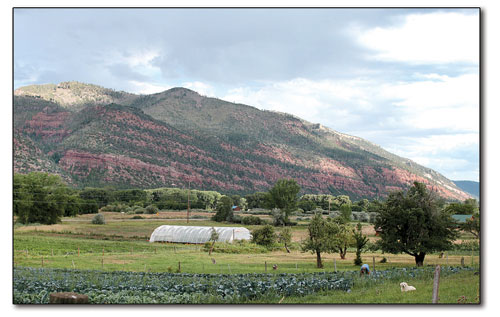
Farmers who depend on the Animas River to water their crops initially wondered if they would face losses because they couldn’t water the produce. Now the focus is on the future of those crops./Photo by Jennaye Derge
Long row to hoe
Animas Valley farmers settle into life after the spill
by Tracy Chamberlin
Tom Markle awoke the morning of Thurs., Aug. 6, to find the ditch water he used for irrigating his farm in the Animas Valley unusually low. “I looked across the highway at the river, and it’s orange,” he said. “My heart sank.”
JusttheFactsWhat: Public meeting on the Gold King Mine Incident |
The owner of 550 Farms, just north of Durango, eventually learned what many other locals were discovering. The morning before, on Aug. 5, the Environmental Protection Agency accidentally unleashed more than 3 million gallons of toxic mine wastewater into the Animas River.
Residents in the West are no strangers to the history of mining in the area or the trickle of heavy metals coming from abandoned mines. But the sudden increase of such large amounts is what makes this situation different.
 Tom Markle, owner of 550 Farms in the Animas Valley, washes off freshly harvested cabbage with water he received from the city./Photo by Jennaye Derge |
Markle said it’s hard to tell how the spill and the sediment left behind will affect the soil. Plants are sensitive, he explained, and certain crops might not show signs for years to come. “I don’t think we’ll ever know,” he said.
The river was closed just over a week, and since Markle gets the bulk of his water from the Animas, all he could do was wait and hope for some rain. He said there was a time when he thought he might have to write off the season.
Linley Dixon, owner of Adobe House Farm, gets water from the same irrigation ditch as Markle. She said at one point they had to move their 200-pound pump, which carries water from holding ponds to the produce, out of the mud. But they were able to make it until the river was reopened.
“It hasn’t been devastating yet,” she added. “We’re pretty lucky.”
James Ranch is another farm that relies on that ditch diverting water from the Animas.
Joe Wheeling, who along with his wife, Jenn, owns the gardens at James Ranch, said the water was shut down first thing Thursday morning – and that’s how it stayed until the EPA and Colorado Department of Public Health and Environment gave the all clear Aug. 14.
They were able to secure a water delivery from the city which, Wheeling said, made all the difference. “There’s no doubt,” he added.
The focus for these local farmers has now shifted. With images of a neon orange Animas everywhere, the concern has changed from losing crops to answering phone calls from customers wondering if the produce is safe to eat.
Darrin Parmenter, director and horticulture agent for the Colorado State University Extension Office, said in an email that while he realizes it might not calm everyone’s fears, the powers that be are saying the river is back to pre-event conditions.
Cause of wildlife deaths unknownTwo deceased beavers were removed from the Animas River between Oxbow Park and Preserve and the 32nd Street crossing on Sat., Aug. 15, by a Colorado Parks and Wildlife officer. It’s unknown if the deaths were related in any way to the mine wastewater released into the Animas River on Aug. 5. |
“The data I’ve seen so far supports this,” he added. “Additionally, many of the metals in the river are now lower than the drinking water standard, thus making them safe for produce.”
This data, organized and released by the EPA and the Colorado Department of Health and Environment, can be accessed through an online database, complete with maps, data points and specific readings for each location. What the database doesn’t say is exactly what it all means for local farmers.
“I don’t know what to think at this point,” Markle said.
Some of the initial test results, taken when the neon orange plume came through the city, showed higher 4 levels of heavy metals and other elements typically found in the river. It included such commonly avoided ones like lead, mercury and arsenic.
Since the plume flowed past and into New Mexico, the EPA has said testing shows the levels of heavy metals and other elements have returned to “pre-incident” levels. Thus, the river is open, the ditches are full and the irrigation water is flowing once again.
The most recent test results, taken Aug. 11, show some metals exceeded what’s considered the background concentration but are also below risk-based concentrations. Those are lead, silver, antimomy and thallium.
All four can be painted with either a sinister or benign brush. Lead paint is now banned because of the damage it caused, but is also part of the familiar No. 2 pencil. Once used in rat poison, thallium is now found in infrared optics and electronics. Antimomy is a common flame retardant and used to be worn as eye makeup by the ancient Egyptians.
What typically makes the difference is the concentration of these elements. And, although, the concentration might be low today, many are worried about what will happen over time.
“That is where I still have some uneasiness,” Parmenter explained. He’s recommending producers insist the EPA continue testing.
“This testing could be on water, sediment, ditch bottoms, soil, or tissue for the foreseeable future,” he said. “We need to know what the longer effects might be on the health of the ecosystem.”
Dixon would like to see the EPA continue testing for at least the next five years. “(This incident) makes you want to know what’s in your food,” she said. “This raises awareness that it can happen everywhere, even in our own town.”
At James Ranch, Wheeling said a drip irrigation system was installed about four years ago, along with a sophisticated sand filtering system to clean out the silt and other debris that could clog the irrigation equipment. This will allow them to filter out metals and other elements that might get stirred up during spring runoff or heavy rain.
But that doesn’t mean testing shouldn’t continue.
“We take our role of providing healthy food to this community very, very seriously,” Wheeling said. He only hopes those responsible for the spill take their role just as seriously.
In this week's issue...
- May 15, 2025
- End of the trail
Despite tariff pause, Colorado bike company can’t hang on through supply chain chaos
- May 8, 2025
- Shared pain
Dismal trend highlights need to cut usage in Upper Basin, too
- April 24, 2025
- A tale of two bills
Nuclear gets all the hype, but optimizing infrastructure will have bigger impact
